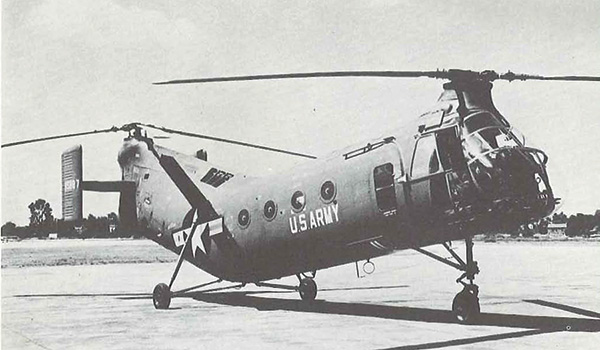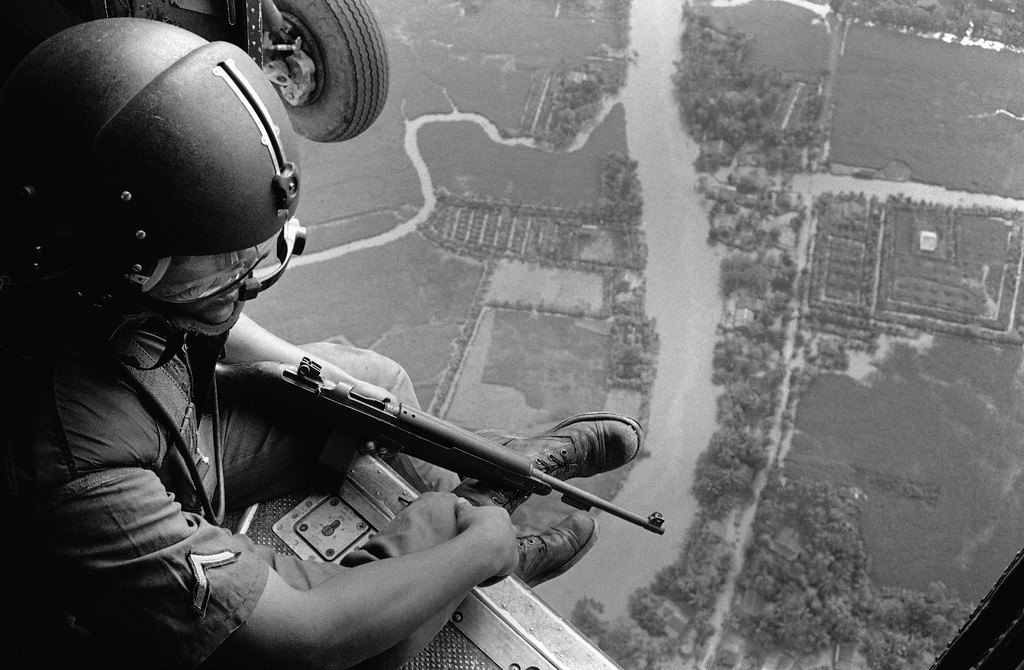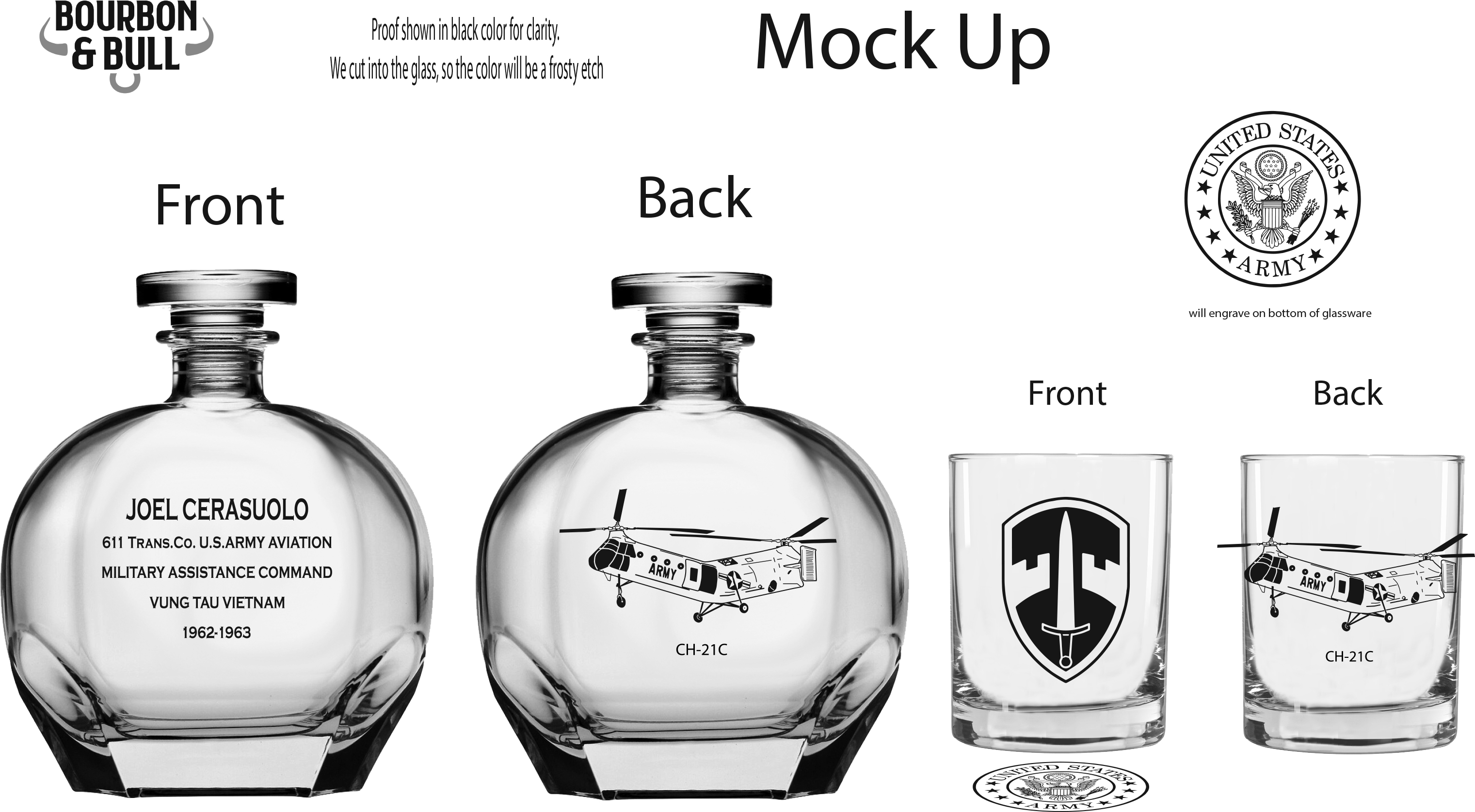Though Joel left Vung Tau in 1963… Vung Tau has never left Joel...
Posted by Jeff Richards on 25th Sep 2020
At Bourbon and Bull, we don’t sell products. Our goal is to help tell your story through imagery that is significant to you. Everyone has a story… we love your stories.
We were recently asked by a customer, Joel, to create two whiskey decanters featuring a CH-21 helicopter, a legacy aircraft produced from 1952 to 1959 and first introduced to Vietnam in 1961. One was for Joel and the other for Dallas, an old Army buddy. We were intrigued by the aircraft and curious about Joel’s connection to it…. so we asked.
Here’s a bit of Joel’s story….
In February of 1961, one month after John F. Kennedy was sworn in as our country’s 35th president, 19 year-old Joel Cerasuolo enlisted in the US Army.
Active in the Civil Air Patrol since getting his pilot’s license at age 16, Joel wanted to see the world that he’d heard about from WWII vets. The Army became the logical choice when Joel learned that they’d guarantee his pursuit of aviation as his Military Occupation Specialty (MOS.)
In the fall of 1961, while at Fort Sill, OK… Joel responded to a call for a voluntary assignment. The unknown assignment was considered hazardous duty and required the ability to pass a top-secret security clearance. Joel waited and waited for months and thought for sure that the opportunity had passed. He spent the summer of 1962 at Fort Bragg, involved in helicopter testing or better put… testing associated activities… like repelling and firing missiles.
Joel believed he was heading back to Fort Sill, when he was diverted to Fort Riley KS. It was there that he learned the special assignment he’d volunteered for almost a year earlier was coming to fruition. There he waited while soldiers assembled from all over the country. He was issued all new gear… a new M-2 and fatigues with draw strings at the ankles. It was only when he received a yellow fever vaccine, that he suspected he’d be heading somewhere very hot.
On October 1, 1962, Joel and 80 others boarded 2 buses en route to the airfield. He still remembers thinking “Oh shit” upon finding a band playing as they disembarked the bus. They boarded a C-135 and began the first leg of a 24-hour journey to their unknown destination.
The first stop was Hickam AFB in Hawaii, then on to Clark AFB in the Philippines. It was only after leaving Clark that a seasoned Sergeant passed out a little envelope to each soldier. Upon opening the envelope, Joel found a new passport and a visa to the Republic of South Vietnam. It was only then that these 80 young men knew their destination.
It was stifling hot when the unit disembarked the C-135 in Saigon. After passing through customs, the group boarded a bus that had chicken wire covering each window. Joel quickly learned that the wire prevented the VC from throwing a grenade into the bus. Welcome to Vietnam…
After a week or so in a tent city, awaiting the arrival of their equipment, they finally got orders to go. “Going” meant forming a convoy of 80 vehicles for the drive to an abandoned airfield at Vung Tau. Joel was selected by a hardened Captain to ride with him, ahead of the convoy, in order to make sure that the bridges were not mined by the VC. To this day, Joel remembers the WWII era Thompson Sub-machine Gun that the captain carried.
Joel’s unit, the 611th TC CO was charged with responsibility for back-up support of aviation units operating in the southern sector of RVN. They handled recovery and repairs to aircraft… they filled bullet holes and cleaned up blood. In the first two years of operation, the 611th recovered 139 downed aircraft, including 54 CH-21s and 43 UH-1s. (34 GS Grp CD prepared by George G. Reese Jr.)
A recovery would entail field stripping a CH-21 of the rotors, engine, and anything else they could remove to lighten it enough to be lifted out. Back at the airfield, they’d either put it back together or add it to the boneyard.
The CH-21, nicknamed the flying banana, saw extensive use in 1962-63 by the US Army in transporting Republic of Vietnam troops and supplies in and out of hostile zones. The helicopter clipped along at 100 knots a few feet above the treetops and rice patties. It wasn’t made for hot climates and this significantly reduced the service life of the engines.

In Joel’s words; “Treetops and rice paddies at 100 knots. There was no MOS as
gunner in 62. I was an aircraft mechanic, Dallas was an aircraft electrician.
We were such a small force in those days we all over lapped job assignments.
Our Cook even doubled as a crew member at times. When you see those bad ass
Huey Door gunners on the B model Hogs with 4 Machine guns and 16 rockets
mounted and the crew chief and gunner each with an M-60 machine gun, think of
us. I had just turned 21 and far from the later versions of assault
helicopters, this is a photo of a typical door gunner in my time. We sat
tethered to the floor in the aft cargo door armed with a fully auto M-2 Carbine
with the stopping power of a Daisy BB gun while the crew chief was in the
forward door with a single .30 cal Machine gun.

Joel notes that in 1962… the VC hadn’t yet learned to “lead” an aircraft with small arms fire. Inevitably, the back of the aircraft had way more holes than the front.
During the 14 months Joel spent with the 611th at Vung Tau, the once adventuresome boy became a man… having witnessed the horrors of this still young, war. Though Joel left Vung Tau many years ago… it still hasn’t left him more than a half a century later.
Joel made a pilgrimage back to Vietnam in 2009, some 46 years of life later. There was little that reminded him of the time he spent there…
In 1962-63, 175 Americans lost their lives in Vietnam. Joel knew a few of these men. On Panel 01E of the Vietnam Veterans Memorial, Joel is transported back to a time when these men still had hopes and dreams for a better tomorrow….

